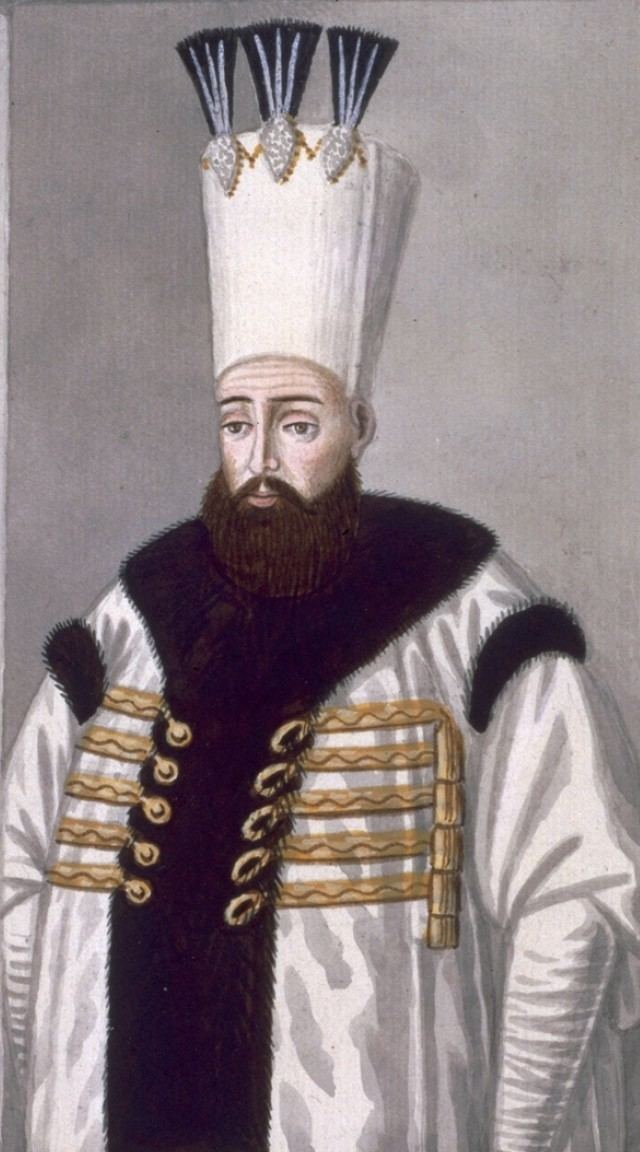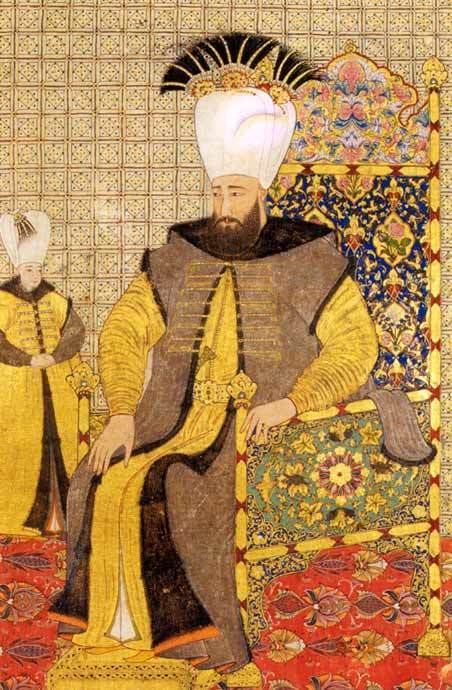Predecessor Mustafa II Royal house House of Osman Name Ahmed III Partner Zeyneb Sultan | Successor Mahmud I Father Mehmed IV Role Sultan | |
 | ||
Reign December 28, 1703 – September 20, 1730 Consorts Emetullah KadinefendiRukiye KadinefendiEmine Mihrisah KadinefendiHatice KadiefendiRabia Sermi KadinefendiEmine Musall KadinefendiHanife KadinefendiGulsen KadinefendiZeyneb KadinefendiUmmugulsum KadinefendiFatma Humasah KadinefendiHurrem KadinefendiMeyli KadinefendiNazife KadinefendiNijad Kadin EfendiAyse Behri KadinefendiHatem KadinefendiSahin KadinefendiHusnisah KadinefendiSayeste Hanimefendi Died July 1, 1736, Topkapi Palace, Istanbul, Turkey Spouse Fatma Huma Sah Sultan, Emetullah Sultan, Meyli Sultan Children Abdul Hamid I, Mustafa III, Esma Sultan, Fatma Sultan Parents Emetullah Rabia Gulnus Sultan, Mehmed IV Similar People Mustafa II, Mahmud I, Mustafa III, Abdul Hamid I, Mehmed IV | ||
Sultan Ahmed III (Ahmed 3) – 23rd Ruler of Ottoman Empire (Saltanat e Usmania) in Urdu & Hindi
Ahmed III (Ottoman Turkish: احمد ثالث Ahmed-i salis) (December 30/31, 1673 – July 1, 1736) was Sultan of the Ottoman Empire and a son of Sultan Mehmed IV (1648–87). His mother was Mah-Pare Ummatullah (Emetullah) Rabi'a Gul-Nus Valide Sultan, originally named Evmania Voria, who was an ethnic Greek. He was born at Hajioglupazari, in Dobruja. He succeeded to the throne in 1703 on the abdication of his brother Mustafa II (1695–1703). Nevsehirli Damat Ibrahim Pasha and his daughter, Hatice Sultan (wife of the former) directed the government from 1718 to 1730, a period referred to as the Tulip Era.
Contents
- Sultan Ahmed III Ahmed 3 23rd Ruler of Ottoman Empire Saltanat e Usmania in Urdu Hindi
- Who is fatma sultan daughter of ahmed iii
- Biography
- Character of Ahmed IIIs rule
- Jahandar Shah
- Farrukhsiyar
- Marriages and issue
- In fiction
- References
Who is fatma sultan daughter of ahmed iii
Biography

Ahmed III cultivated good relations with France, doubtless in view of Russia's menacing attitude; in fact, both his wives were Frenchwomen. He afforded refuge in Ottoman territory to Charles XII of Sweden (1682–1718) after the Swedish defeat at the hands of Peter I of Russia (1672–1725) in the Battle of Poltava of 1709. In 1710 Charles XII convinced Sultan Ahmed III to declare war against Russia, and the Ottoman forces under Baltaci Mehmet Pasha won a major victory at the Battle of Prut. In the aftermath, Russia returned Azov back to the Ottomans, agreed to demolish the fortress of Taganrog and others in the area, and to stop interfering in the affairs of the Polish–Lithuanian Commonwealth.
Forced against his will into war with Russia, Ahmed III came nearer than any Ottoman sovereign before or since to breaking the power of his northern rival, whose armies his grand vizier Nevsehirli Damat Ibrahim Pasha succeeded in completely surrounding at the Pruth River Campaign in 1711. The subsequent Ottoman victories against Russia enabled the Ottoman Empire to advance to Moscow, had the Sultan wished. However, this was halted as a report reached Constantinople that the Safavids were invading the Ottoman Empire, causing a period of panic, turning the Sultan's attention away from Russia.
Sultan Ahmed III had become unpopular by reason of the excessive pomp and costly luxury in which he and his principal officers indulged; on September 20, 1730, a mutinous riot of seventeen Janissaries, led by the Albanian Patrona Halil, was aided by the citizens as well as the military until it swelled into an insurrection in front of which the Sultan was forced to give up the throne.
Ahmed voluntarily led his nephew Mahmud I (1730–54) to the seat of sovereignty and paid allegiance to him as Sultan of the Empire. He then retired to the Kafes previously occupied by Mahmud and died at Topkapi Palace after six years of confinement.
Character of Ahmed III's rule
The reign of Ahmed III, which had lasted for twenty-seven years, although marked by the disasters of the Great Turkish War, was not unsuccessful. The recovery of Azov and the Morea, and the conquest of part of Persia, managed to counterbalance the Balkan territory ceded to the Habsburg Monarchy through the Treaty of Passarowitz, after the Ottoman Empire was defeated in Austro-Turkish War of 1716–18. In 1716, he sent an army of 33,000 men to capture Corfu from the Republic of Venice.
Ahmed III left the finances of the Ottoman Empire in a flourishing condition, which had remarkably been obtained without excessive taxation or extortion procedures. He was a cultivated patron of literature and art, and it was in his time that the first printing press authorized to use the Arabic or Turkish languages was set up in Constantinople, operated by Ibrahim Muteferrika (while the printing press had been introduced to Constantinople in 1480, all works published before 1729 were in Greek, Armenian, or Hebrew).
It was in this reign that an important change in the government of the Danubian Principalities was introduced: previously, the Porte had appointed Hospodars, usually native Moldavian and Wallachian boyars, to administer those provinces; after the Russian campaign of 1711, during which Peter the Great found an ally in Moldavia Prince Dimitrie Cantemir, the Porte began overtly deputizing Phanariote Greeks in that region, and extended the system to Wallachia after Prince Stefan Cantacuzino established links with Eugene of Savoy. The Phanariotes constituted a kind of Dhimmi nobility, which supplied the Porte with functionaries in many important departments of the state.
Jahandar Shah
In the year 1712, the Mughal Emperor Jahandar Shah, a grandson of Aurangzeb sent gifts to the Ottoman Sultan Ahmad III and referred to himself as the Ottoman Sultan's devoted admirer.
Farrukhsiyar
The Mughal Emperor Farrukhsiyar a grandson of Aurangzeb, is also known to have sent a letter to the Ottomans but this time it was received by the Grand Vizier Nevsehirli Damad Ibrahim Pasha providing a graphic description of the efforts of the Mughal commander Syed Hassan Ali Khan Barha against the Rajput and Maratha rebellion.
Marriages and issue
He married Amina (Emine) Mihr-i-Mah Sultan and Rabi'a Sermi Sultan. By the first wife he had Mustafa III and by the second wife he had Abdul Hamid I. One of his daughters was Zeynep Asime Sultan. Zeynep Sultan Mosque was built by her order. Fatma Sultan was also his daughter and was married to grand vizier Nevsehirli Damat Ibrahim Pasha, by whom she directed the government from 1718 to 1730, a period referred to as the Tulip Era.
In fiction
In Voltaire's Candide, the eponymous main character meets the deposed Ahmed III on a ship from Venice to Constantinople. The Sultan is in the company of five other deposed European monarchs, and he tells Candide, who initially doubts his credentials:
I am not jesting, my name is Achmet III. For several years I was Sultan; I dethroned my brother; my nephew dethroned me; they cut off the heads of my viziers; I am ending my days in the old seraglio; my nephew, Sultan Mahmoud, sometimes allows me to travel for my health, and I have come to spend the Carnival at Venice." [1]
This episode was taken up by the modern Turkish writer Nedim Gursel as the setting of his 2001 novel Le voyage de Candide a Istanbul.
In fact, there is no evidence of the deposed Sultan being allowed to make such foreign travels, nor did Voltaire (or Gursel) assert that it had any actual historical foundation.
